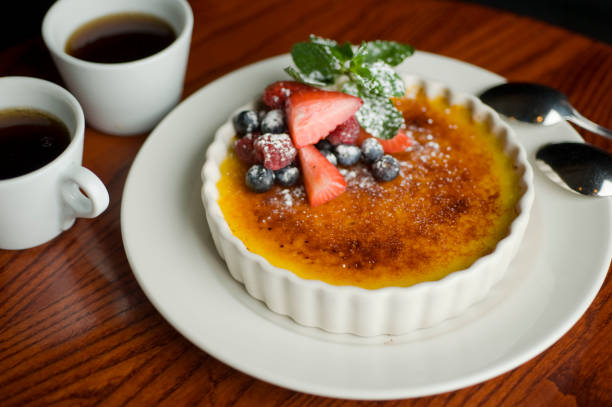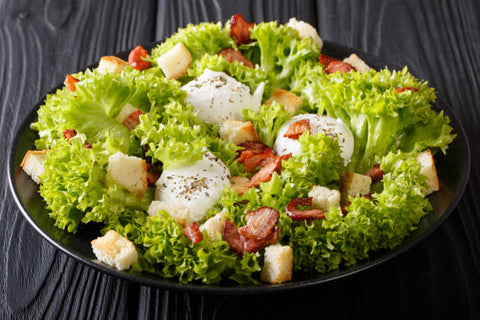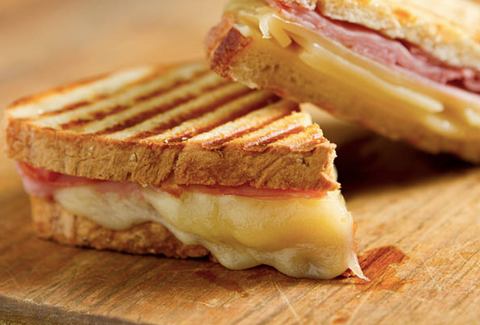Crème brûlée has been called the "king of desserts," a name it shares with chocolate mousse and also soufflé. It is one of many desserts made with a custard base, meaning that it uses eggs as its thickener. In French, crème brûlée is translated as burnt cream.
The custard base is prepared with egg yolks, heavy cream, and vanilla. The mixture is poured into shallow ramekins and baked in a water bath until set but slightly wobbly in the center. Once chilled and ready to serve, the top layer of sugar is caramelized under an oven broiler or with a butane torch before serving. This final step gives crème brûlée its signature crackling top.
Crème Brûlée is mostly composed of:
Crème brûlée is delicious custard with a burnt sugar topping, traditionally made with egg yolks, cream, and vanilla. The texture is silky smooth, and the taste is rich, creamy, and decadent.
Crème brûlée has only four ingredients:
- Egg yolks
- Cream (or half & half)
- Sugar
- Vanilla extract.
These are the staples that you'll always need for this recipe.
It's important to use heavy cream because it results in thicker custard that sets up nicely. If you use milk or half & half instead of cream, the custard will be too thin (and therefore won't set properly), and the flavor won't be as rich.
Crème Brulee is a French Dessert
Crème brûlée (French for "burnt cream") is a dessert consisting of a rich custard base topped with a contrasting layer of hard caramel. It is usually served at room temperature.
The custard base is traditionally flavored with vanilla but can have a variety of other flavorings, such as chocolate or coffee.
A few other desserts are similar to crème brûlée but differ in ingredients and texture.
- For example, in Spain, we have the Catalana cream that also has a creamy texture and is very similar, but it's not burnt; it's cooked on low heat until the sugar melts and forms a sticky, golden caramel layer on top.
- The Catalan cream is made with egg yolks, sugar, and milk only, plus some lemon zest or cinnamon stick for flavoring.
Taste of Crème Brûlée
As a dessert, crème brûlée is very creamy, rich, and delicious. According to bbcgoodfood website, as its name suggests, it has a slightly caramelized and burnt taste, making it very tasty.
Crème brûlée is rich custard topped with an even richer caramelized topping. The custard has a velvety smooth texture, and the topping is crisp, like candy.
- The custard part of crème brûlée is slightly different from what you might find in other desserts. While it does have eggs, you can expect a lower fat content than some other creamy desserts.
- The base for this dessert is usually heavy cream. Many recipes call for vanilla extract, but you can easily substitute a vanilla bean or another flavoring such as citrus zest or liqueurs.
Speciality of Crème Brûlée
Crème brûlée is a rich custard base topped with a contrasting layer of hard caramel. It is normally served at room temperature. The custard base is traditionally flavored with vanilla but can have a variety of other flavorings.
The custard base is typically enriched with egg yolks and cream (or half-and-half), giving it a smooth consistency that contrasts with the crunchy caramel topping. The dish can be served cold if refrigerated for several hours but is usually lukewarm. The contrast of the cold, creamy custard and the warm, hard topping makes for a popular dessert.
Popularity of Crème Brulee in UK
Crème brûlée is probably the best thing that ever happened to us in UK. This delicate desert is rich custard topped with a layer of hard caramel, which cracks loudly when pierced with a spoon. In French, it means "burnt cream," but it's not burnt—it just has a light browned top.
The earliest mention of crème brûlée can be found in François Massialot's 1691 cookbook Cuisinier Royal et Bourgeois. But this insanely delicious dessert has been around for much longer than that. The first version of crème brûlée was called "trifle" and was a simple milk pudding with fruit and wine-soaked rusk. Trifle dated back to the 16th century and originated either in Italy or England.
- However, the trifle was so popular in Europe at the time that it managed to spread all over the continent, and different countries developed their versions of this dessert.
- The French called it "creme Anglaise," meaning "English cream," even though there's nothing particularly English about it.
Is Crème Brûlée served warm?
Crème brûlée is a dessert that is best served cold. There are various recipes for crème brûlée, but the base recipe includes eggs and cream. To make crème brûlée, you must add egg yolks and sugar to a bowl and whisk them together until they are light yellow.
In France, a common practice is to serve crème brûlée hot out of the oven, but this is not traditional and does not taste as good as when served cold.
- It should be noted that there are many different variations of crème brûlée in existence today, and some restaurants will serve this dessert warm or even lukewarm.
- This practice may have originated from cooks trying to save time by preparing their custards ahead of time and simply heating them when serving customers.
How Creme Brulee smell like?
What does crème brûlée smell like? I've been trying to find a perfume that smells like that sweet, creamy, vanilla custard since I can remember.
What is it about this dessert that makes it so appealing?
- It could be the contrasting textures of the caramelized sugar and silky custard or the balance of sweet and bitter in every bite.
- In French, crème brûlée means burnt cream, which makes sense considering the custard is topped with a layer of caramelized sugar. The recipe dates back to the 17th century but was not called by its name until around 1926, according to Larousse Gastronomique.

Variations of Crème Brulee
In France, there are many variations of crème brûlée depending on the region. For example, Spanish cuisine has creme Catalana similar to crème brûlée but includes orange zest for flavor. In England, there is a similar dessert called trifle which contains layers of cake soaked in liqueur or fruit juice, fruit, and custard topped with whipped cream.
Crème brûlée is a simple dessert consisting of egg yolks, cream, and sugar, making it rich in flavor and calories!
Difference between Creme Brulee and Creme Caramel
Creme brulee and creme caramel are both classic French custards. They are the same in that they are both egg-based custards that consist of milk, sugar, and vanilla.
What is the difference?
The main difference is that creme caramel has a layer of caramel at the bottom that has been cooked in a pan and then inverted before serving. As a result, it is smooth, creamy, and rich, with a hint of brown sugar in every bite.
Creme Brulee has a hard caramel top layer made by sprinkling sugar over the top of the custard and then using a torch to melt it until it becomes crunchy. Then it can be cracked with a spoon before you eat it.
Is Egg Custard the same as Creme Brulee?
Egg custard and creme brulee are not the same. The main difference between the two is that creme brulee is topped with a layer of sugar that caramelizes under a broiler or torch, resulting in a crunchy, burnt sugar topping. Egg custard does not have this additional layer of sugar, but some recipes call for a dusting of nutmeg or cinnamon.
Is Crème Brûlée Healthy?
Crème brûlée is rich custard topped with caramelized sugar. It's a dessert that's not only tasty and sweet, but it also carries a sense of status and accomplishment when you prepare it well.
But is crème brûlée healthy? If we're being honest, not really, the dessert consists of sugar, cream, and eggs. These ingredients are all high in saturated fat and contain cholesterol.
- However, if you're going to indulge in crème brûlée, why not do it right? With a few healthier ingredient swaps, you can make the dessert a little less damaging to your body and even boost its nutritional value.
Can we Substitute Milk for Cream in Creme Brulee?
Creme brulee is sweet custard that uses a good amount of cream. As a result, it has a rich, creamy flavor that's hard to beat. But does it need all of that cream? Can you substitute milk for cream in creme brulee?
- Creme brulee is French for burnt cream, which refers to the caramelized sugar on top of the custard. It's made by cooking eggs and cream until just set and then pouring it into ramekins. After baking, the custard cools and is topped with sugar, torched to create a crisp, caramelized shell. The crunchy sugar topping contrasts nicely with the soft custard underneath.
- It's important to use high-quality ingredients when making creme brulee because it's a simple dish. There are only four ingredients — eggs, cream, sugar, and vanilla — so each one needs to shine through on its own.
- However, if you're trying to cut calories or make the recipe more accessible to those who are lactose intolerant, there are some creative ways to substitute milk for cream in creme brulee.
While some recipes from cooking nytimes call for half-and-half or light whipping cream instead of heavy whipping cream or full-fat milk.
Sometimes Creme Brulee is not smooth
Creme brûlée is not smooth custard; it's quite grainy. That's the way it is supposed to be!
The most common cause of an overly smooth creme brûlée is over whisking. If you over whisk the eggs, they incorporate too much air and puff up in the oven. You can see this happen if you watch through the oven door.
- Another possible cause is under baking. The custard should be set but still jiggle when shaken gently, not remain liquid.
- If the custard is too liquid, the eggs will have a harder time setting properly and will have a curdled texture rather than a grainy texture when they do set.
What to use instead of heavy cream for Creme Brulee
You can use crème Fraiche instead.
Crème Fraiche is a cultured cream that is thicker and more stable than the heavy cream that crème brûlée is usually made with. It has a tangy, slightly fermented flavor available in many supermarkets (the regular kind, not the low-fat). The only important difference between it and heavy cream is its fat content: crème Fraiche has about 30% fat and heavy cream about 40%. So you might need to add extra sugar to your Brulee mixture if you use it.
- The simplest substitute is melted butter mixed with two parts whole milk. This will give you the same consistency as heavy cream, but with a little less fat and fewer calories.
- Another option is to mix equal parts of evaporated milk and water. This will also give you a cream-like consistency, but it won't whip up quite like heavy cream.
- You can also try full-fat coconut milk. It's not only lighter than heavy cream; it's also vegan if that matters to you.
None of these substitutes will give you the same flavor or texture as heavy cream, so stick with the real thing if it's important for your recipe as in the recipe of foodnetwork website.
Best Sugar for Crème Brûlée
This is a great question! I think the differences between sugars may be subtle, but there's a difference. My favorite sugar for crème brûlée is Demerara sugar from India. It has larger, less processed crystals and quite a bit of flavor. If you caramelize it slightly and then let it cool, the caramelized sugar hardens into a chewy crust that adds texture to the custard.
The second best option is turbinado sugar from Hawaii. The crystals are smaller than Demerara, and it lacks some of the molasses-y flavors of Demerara, but it still makes a good crunchy crust on top of the custard.
The ultimate refined white sugar would be caster (superfine) or bar (granulated) sugar. It also goes by "bakers" or "baking" sugar. It has very small crystals and no flavor at all, but it will make a nice crispy crust on top of your custard.




